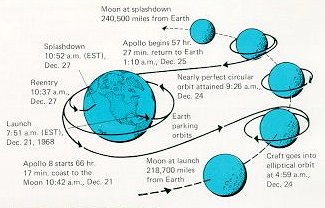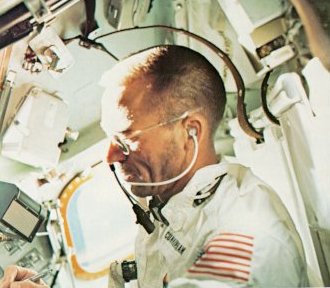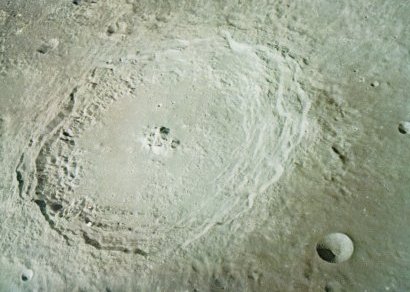Apollo Expeditions to the Moon
LIFTING FROM A SEA OF FLAME
In the pink dawn of December 21 a quarter million persons lined the approaches
to Cape Kennedy, many of them having camped overnight. At 7:51, amid a noise
that sounded from three miles away like a million-ton truck rumbling over a corrugated
road, the first manned Saturn V, an alabaster column as big as a naval destroyer,
lifted slowly, ever so slowly, from the sea of flame that engulfed Pad 39-A. The
upward pace quickened as the first stage's 531,000 gallons of kerosene and liquid
oxygen were thirstily consumed, and in 2 minutes 34 seconds the big drink was
finished, whereupon the second stage's five J-2 engines lit up. S-II's 359,000 gallons
of liquid hydrogen and liquid oxygen boosted the S-IVB and CSM for 6 minutes
10 seconds to an altitude of 108 miles. After the depleted S-II fell away, the S-IVB,
this time the third stage, fired for 2 minutes 40 seconds to achieve Earth orbit. Except
for slight pogo during the second-stage burn, Commander Borman reported all was
smoothness.
| | |
Intently watching the dials above them, the crew
of Apollo 8, Anders , Lovell, Borman, left to right,
rehearse for their lunar orbit mission inside a
simulator at the Kennedy Space Center. Simulation
was a central feature of the training given
flight crews and mission controllers.
|

|
Like a whirling dervish, the path of Apollo 8
about the Earth and Moon spanned seven days
and well over half a million miles. Ten lunar
revolutions, at distances as close as 60 miles, were
made. Translunar trip takes about 20 percent
longer than the return trip because going out one
has to overcome the stronger gravity of the Earth
but can capitalize on it coming back. Not shown
is the solar orbit trajectory taken by the burned
S-IVB stage.
|
During the second orbit, at 2 hours 27 minutes, CapCom Mike Collins sang out
"You are go for TLI" (translunar injection), and 23 minutes after that Lovell calmly
said, "Ignition". The S-IVB had restarted with a long burn over Hawaii that lasted
5 minutes 19 seconds and boosted speed to the 24,200 mph necessary to escape the
bonds of Earth. "You are on your way", said Chris Kraft, from the last row of consoles
in Mission Control, "you are really on your way". The anticlimactic observation of the
day came when Lovell said, "Tell Conrad he lost his record". (During Gemini 11 Pete
Conrad and Dick Gordon had set an altitude record of 850 miles.) After the burn the
S-IVB separated and was sent on its way to orbit the Sun.
| | |
Brightly lit panel lights and screens confront Green Team Flight Director for Apollo 8,
Cliff Charlesworth, at his console in the Mission Control Room in Houston.
The radio signal between here and the Moon took three seconds roundtrip.
|
In Mission Control early in the morning of December 24 the big center screen,
which had carried an illuminated Mercator projection of the Earth for the past three
and one-half years - a moving blip always indicated the spacecraft's position - underwent
a dramatic change. The Earth disappeared, and upon the screen was flashed a
scarred and pockmarked map with such labels as Mare Tranquillitatis, Mare Crisium,
and many craters with such names as Tsiolkovsky, Grimaldi, and Gilbert. The effect
was electrifying, symbolic evidence that man had reached the vicinity of the Moon.
| | |
Walt Cunningham, lunar module pilot on Apollo 7 (which carried no
LM), makes notes while a spare film magazine floats weightlessly a few
inches above his pen. To "park" something in space, it had to be left
with zero motion.
|
CapCom Gerry Carr spoke to the three astronauts more than 200,000 miles away,
"Ten seconds to go. You are GO all the way." Lovell replied, "We'll see you on the
other side", and Apollo 8 disappeared behind the Moon, the first time in history men
had been occulted. For 34 minutes there would be no way of knowing what happened.
During that time the 247-second LOI (lunar orbit insertion) burn would take place
that would slow down the spacecraft from 5758 to 3643 mph to enable it to latch on
to the Moon's field of gravity and go into orbit. If the SPS engine failed, Apollo 8 would
whip around the Moon and head back for Earth on a free-return trajectory (á la Apollo
13); during one critical half minute if the engine conked out the spacecraft would be
sent crashing into the Moon.
| | |
Terraced inner walls lead from the rim of the crater Langrenus down
to the smooth crater floor, broken by some central peaks. Langrenus is
about 85 miles in diameter and its smooth, worn walls suggest that it is
fairly old. The photo was taken from an altitude of some 150 miles.
|

|
Slashing across the floor of the crater Goclenius, which
is about 40 miles in diameter, are strange trenches called
rilles. One rille extends over the entire crater floor, across
the central peak, and continues up over the rim and out
along the surrounding mare. This is only part of an
Apollo 8 telephoto negative.
|
|






